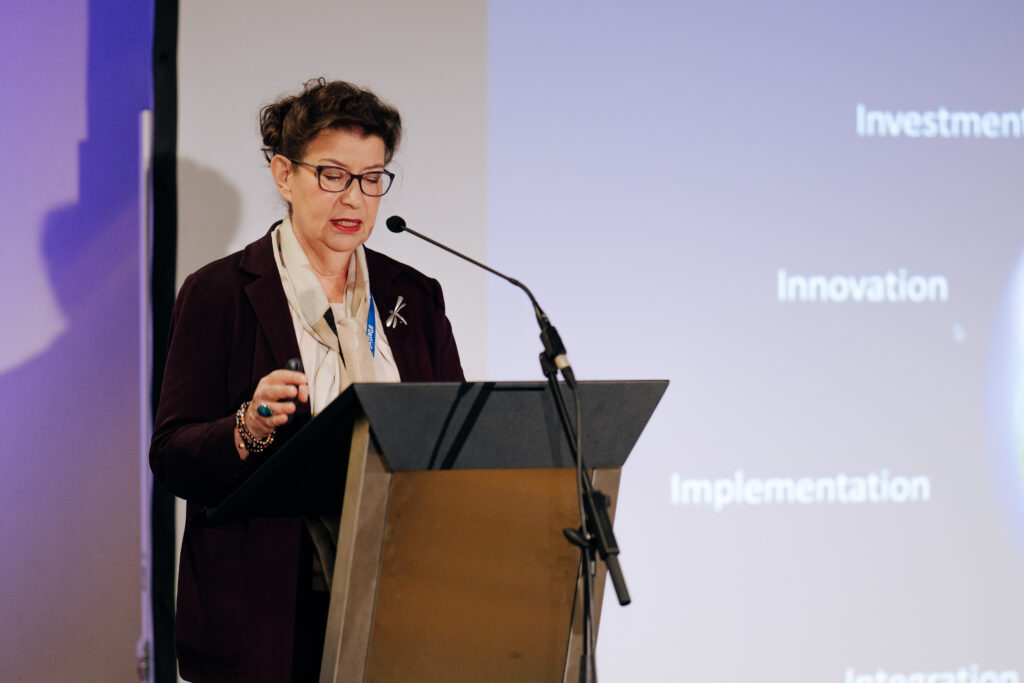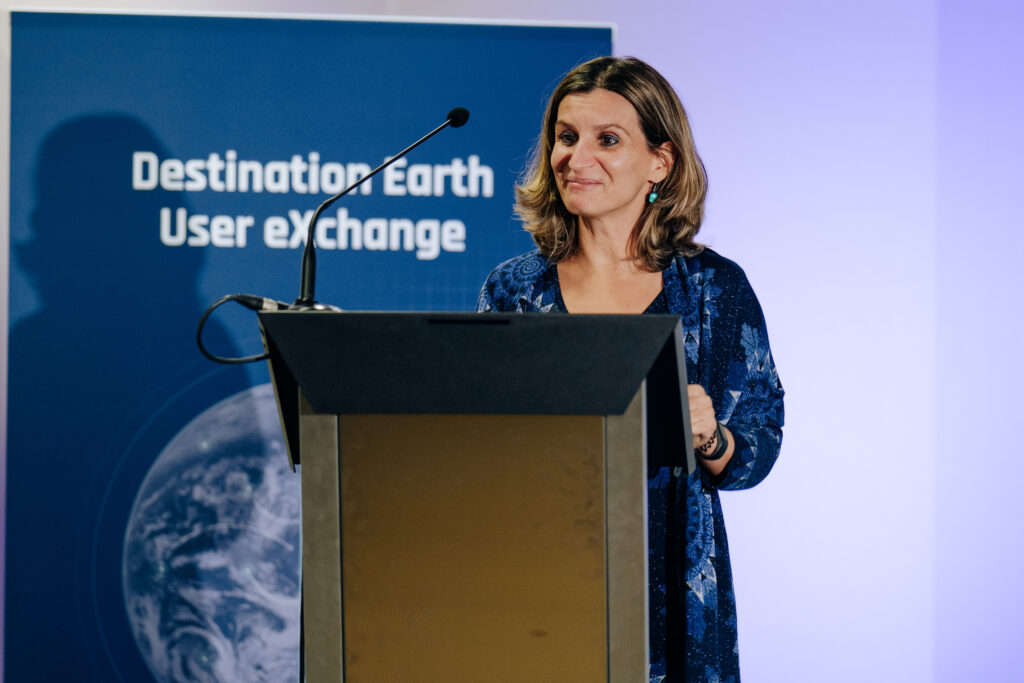DestinE partners share progress at the 2nd User eXchange in Bonn
“The 2nd DestinE UserInstitutions or individuals exploiting DestinE capabilities, More eXchange was an exciting, productive and inspiring event. DestinE aims to push the boundaries of what is possible today in this area and users are an integral part of it and central to its success.”
Team Leader for Destination Earth Charalampos Tsitlakidis (European Commission)
Destination Earth (DestinE) has evolved significantly over the last few months to bring forward a digital twin of the Earth system supporting decision-making in face of the challenges of climate change and the green transition. The effort is led by the European Commission and developed by the three entrusted entities, the European Centre for Medium-Range Weather Forecasts (ECMWFEuropean Centre for Medium-Range Weather Forecasts More), the European Space Agency (ESA) and the European Organisation for the Exploitation of Meteorological Satellites (EUMETSAT).
The 2nd User eXchange meeting hosted by ECMWFEuropean Centre for Medium-Range Weather Forecasts More in Bonn, where the ECMWFEuropean Centre for Medium-Range Weather Forecasts More DestinE activities are led, showcased these developments as an opportunity to share progress with the DestinE community and listen to users’ requests and remarks.
The main elements of the flagship initiative of the European Union are taking shape quickly and will be assembled for the first tests in the coming months. In parallel, the DestinE community keeps building amid a growing interest in the initiative from local, regional, national and international authorities and research centres. DestinE is targeting a co-design and co-development strategy for which meetings of this nature are pivotal.
“Destination Earth has the capacities to monitor, simulate and predict the interaction between natural phenomena and human activities. This initiative, your initiative, will contribute to achieving the objectives of the twin transition, green and digital, and with this, we will be better prepared to respond to major natural disasters, adapt to climate change and predict the socioeconomic impacts.”
Executive Director Leena Ylä-Mononen (European Environment Agency)
Shaping effective climate policies and innovative perspectives
The 2nd DestinE UserInstitutions or individuals exploiting DestinE capabilities, More eXchange, co-organised by ECMWFEuropean Centre for Medium-Range Weather Forecasts More, ESA and EUMETSAT gathered more than 200 participants in presence and 200 registered online for two days of lively exchanges, knowledge sharing and presentations of the main components of the future digital twin of the Earth system.

In her welcome speech, Director-General Florence Rabier (ECMWFEuropean Centre for Medium-Range Weather Forecasts More) said DestinE is “the right tool at the right moment” as climate change accelerates, with a growing number of impacts such as extreme weather events and an initiative showing “European excellence, that shows European Leadership.”
Acting Director for the Digital Excellence and Science Infrastructures Gustav Kalbe (DG CNECT, EC) celebrated the progress made since the 1st User eXchange in Frascati, Italy, hosted by ESA in February 2023, and encouraged participants to make the most of the two days of exchanges.

Opening the second day of exchanges, Executive Director Leena Ylä-Mononen (EEA), detailed the high expectations that the agency has in DestinE, as a tool that will not only provide key environmental data to help implementing more effective climate change mitigation and adaptation policies, but also providing innovative perspectives on the impact of human activity.
An ever-growing collective effort
The 2nd User eXchange started with an introduction of the main elements of the system and the progress by the three entrusted entities.
Destination Earth Director Irina Sandu (ECMWFEuropean Centre for Medium-Range Weather Forecasts More) presented the first two high-priority digital twins, on Weather-Induced Extremes and Climate Change Adaptation and the Digital Twin Engine, saluting a truly European and collective effort, with some 60 entities from more than 20 countries involved in DestinE, and opportunities open to include many more.

The Extremes Digital Twin (DT), developed in part at ECMWFEuropean Centre for Medium-Range Weather Forecasts More and in part by a large consortium of European services led by Météo France, is already producing the first results simulating localised extreme events at sub-km scales. Irina Sandu also unveiled some of the progress in the Climate DT, an unprecedented effort to operationalise climate projections updated at least every year, compared to the current systems based in research delivering updates only every several years.
The Climate DT is developed by a consortium of the leading European centres for climate modelling, and it is moving forward quickly under the coordination of CSC IT Center for Science, with the help of dedicated use cases that are already sharing their needs and requirements for the system. The team has already setup the configuration of advanced high-resolution (5km and 10km).
Progress is also significant in the Digital Twin Engine, the software infrastructure that will be at the foundations of DestinE architecture and that allows the digital twins to operate in some of the largest supercomputers in the world, thanks to the special access granted by EuroHPC to several of its systems. ECMWFEuropean Centre for Medium-Range Weather Forecasts More also presented Polytope, MultIO and Plume software that will contribute to handle the large volumes of data produced by the digital twins.
ESA has also made substantial progress building the DestinE ServiceRegular provision of technological capabilities, resources, More Platform (DESP). Deputy DestinE Project Manager Kathrin Hintze (ESA), presented the first glance of what this central interface of DestinE will be capable of, developed later in a dedicated session and during the poster session. Hintze explained how the DESP is being developed in close collaboration with users, that are central, co design being a top priority from the development phases.
The DESP is conceived as an accessible, configurable and open framework fostering an ecosystem of users or third-party activities maximising interoperability with other ecosystems and as such it will include access to existing initiatives and ecosystems such as the European data spaces, the Copernicus Climate and Atmosphere data stores and EUMETSAT data. The list is open and will evolve according to the users’ requirements.

The progress made on DESP since the first User eXchange in February 2023 is thanks to a consortium of key industry players led by Serco. The platform is already being tested in alpha version with a number of use cases and it will be opened by June 2024.
ESA Use Cases procurement lead Claudia Vitolo (ESA) later presented the DestinE Communications Strategy, coordinated with ECMWFEuropean Centre for Medium-Range Weather Forecasts More and EUMETSAT, oriented towards creating a lively community of users and providers that will be shaping the initiative. The central point of access to the community is the joint DestinE website.
The DestinE Data Lake (DEDL)Self-standing DestinE system component, interfacing with the More, developed by EUMETSAT, is another pillar making DestinE an unprecedented information system. The DEDL brings together the data from the digital twins, ESA, EUMETSAT, the Copernicus services and many other federated repositories.
“The work in the DEDL is progressing very well and according to plan. In the coming months we will integrate the DESP and our Data Bridges with the initial digital twins executed at the HPC centres in LUMIOne of the EuroHPC pre-exascale supercomputers, hosted and o More and LeonardoOne of the EuroHPC pre-exascale supercomputers, hosted and o More. Having at hand initial data from the Digital Twins and for already implemented data federations is a very exciting step. The DestinE DL will also include access to socioeconomic data sources such as Eurostat, and in the future data from European Green Deal data spaces once they are ready. DestinE will be a unique European undertaking to find answers to “What-If” questions about our climate, weather and environment but also about the human print on the Planet,” said DestinE DEDL System Manager Michael Schick (EUMETSAT), who presented the latest developments.
The management of such large datasets will be made possible by the Harmonized Data Access (HDA), an application programming interface (API) based on the data federation principle using a Federated Data Provider system as well as co-located data.
This introductory session was closed by an overview of the innovative visualisation and immersive technologies being developed to display, explore and analyse such a wealth of data available for all. Exprivia, working both with ESA and ECMWFEuropean Centre for Medium-Range Weather Forecasts More provided a glimpse into the prototypes they are working on.

This introductory session was closed by an overview of the innovative visualisation and immersive technologies being developed to display, explore and analyse such a wealth of data available for all. In addition, EUMETSAT gave an overview of lessons we can learn about visualising geospatial data from experience with other EU Programmes.

The true objective of the DestinE’s User eXchange events is to facilitate a multipolar dialogue involving all the actors, from end-users to decision makers including science and technology partners.
The programme crafted by the three entrusted entities was carefully designed to put the emphasis on open exchanges between participants. The poster session was the occasion for many scientists to meet partners using the applications they are developing for the first time and hear about their requests and needs, first-hand. Many participants highlighted the unusual level of engagement and lively debates around the posters. The posters submitted by teams from the three entities, partners and contractors can be accessed on this page.

Technology Partnerships Lead Thomas Geenen (ECMWFEuropean Centre for Medium-Range Weather Forecasts More) proposed a “Coffee table” discussion where participants had the task to find their own pathway to use DestinE, based on a given project. The session generated interesting discussions on the possibilities and the constraints. Geenen introduced the collaboration projects with associate Horizon EU projects to ensure the interoperability of different digital twins based on a common architecture.
Computer Systems Engineer Danaële Puechmaille (EUMETSAT), coordinated a session dedicated to Data Space and the DestinE DataEarth-system monitoring and prediction system output as prov More Lake where the European metereological satellites operator provided more details about the exact architecture and configuration of the DestinE DataEarth-system monitoring and prediction system output as prov More Lake and invited partners involved in other major projects of the European environmental data space.
Project Manager Inés Sanz Morere (ESA) conducted a lively talk where the contractors in charge of the DESP unveiled some of the features of the future interface of DestinE and a hint of its look and feel. ESA also detailed the ambitious vision and first steps for an open platform that will be the entry point for the DestinE ecosystem and a wide range of services and data.
The sessions covered the main aspects of the ambitious initiative. Participants highlighted the high degree of maturity of the components reached within a few months and left Bonn with the confidence that DestinE is building up a true community that will take Earth observation information systems to the next level.
The next User eXchange details are yet to be determined, but the door of the DestinE community is always open via the website and the three entrusted entities
Discover a collection of the event photos at this link.
Make sure you don’t miss important DestinE updates. Join the DestinE Community now.
